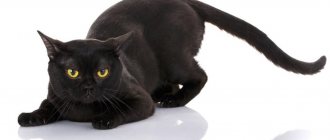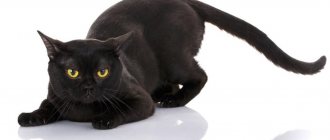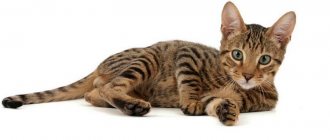- Cats
Bombay cats, or simply Bombays, can be purchased in Russian or foreign clubs and nurseries. Bombays are also sold by private owners who do not have official permission to breed this breed of cats, but still do it accidentally or planned.
A Bombay kitten is inexpensive compared to many other breeds. Private owners sell Bombays for an average of 5-7 thousand rubles, and the cost of kittens in nurseries starts from 20,000 rubles. In clubs, the minimum price threshold is slightly lower - 15-17 thousand rubles. The cost of kittens varies depending on their age, appearance, level and location of the club or nursery.
Nurseries and clubs provide a full package of documents for kittens sold, and also vaccinate kittens (according to age). Kittens sold by private individuals are mostly of unconfirmed origin, so there may be unpleasant surprises. When buying a kitten from a foreign cattery, you should make sure to book it in advance and think about how to deliver the Bombay.
bombay kittens
What information and documents must a Bombay breeder provide?
Breeders do not have a regulated list of information that they are required to provide to their customers. However, not only conscience, but also competition among Bombay breeders provokes them to qualitatively inform clients about everything that concerns the chosen kitten, thereby providing not only a high-quality “product”, but also a high-quality service. This will undoubtedly benefit buyers.
It is worth noting that persons who sell Bombays without documents, that is, kittens resulting from illegal mating, rarely provide useful information about the pets, since they simply do not know it. According to the new standards, nursery staff must have a “zoological” education, so they can provide complete information about cats and give professional recommendations on care and maintenance. Pedigree kittens must have a certificate, which the owners can then independently exchange for a pedigree (for a fee) and a veterinary passport.
In addition to clubs and nurseries, there are also breeders, but when purchasing a kitten from them, be careful and attentive - many of them do not breed legally. You can buy a Bombay cat from such a private person cheaper, but there is always some risk - whether it is really a purebred kitten, whether it has had all the vaccinations. Be sure to ask for documents about them - otherwise there is a possibility that an unscrupulous nursery or breeder included payment for vaccinations in the price of a Bombay cat, but in fact did not provide vaccinations. This is not only an unpleasant loss of money, but also very dangerous for the health of the animal. Many purebred kittens are predisposed to various diseases at an early age.
How not to make a mistake when choosing a furry friend?
Experts will tell you that breeding and selling Bombay cats is not a very profitable business, since they usually have few kittens in a litter, and the cats themselves are somewhat lazier than representatives of other breeds, so mating does not always end successfully. But the black Bombay cat is very beautiful, so there will always be many who want to have such a panther at home, despite all the difficulties. In addition, she will become a faithful and devoted friend to all family members, although she will choose one person as the “main” owner, like a dog.
If you decide to buy a Bombay cat, spend time not only looking at photos of the breed and reading reviews about it, but also about nurseries and breeders in order to choose the best place for you in terms of price and quality where you will buy a kitten. Usually you can choose your future pet at a very early age, but take it home no earlier than 3-4 months, so that the pet is already old enough and independent. Buying a living creature is a responsible process, so try to approach it with all seriousness, after consulting with all family members.
History of origin
At the beginning of the last century, one of the American breeders named Nicky Horner wanted to try to breed a completely black cat. To do this, she crossed the Burmese and American Shorthair breeds. The kittens that were born looked like panther cubs. In 1958, the Bombay cat was officially registered in the list of breeds, gaining the right to take part in exhibitions only after 20 years.
Breeders say that it is very difficult to get a perfectly black Bombay kitten. The peculiarity is that when crossing two Bombays, you can get a cub with a “sable” color, which is a disqualifying feature at exhibitions (two genes, when fused, cause recession). And the Burmese and Bombay cats produce charcoal-colored kittens. In England, Burmese were crossed with ordinary black cats, without paying much attention to the breed. That is why slightly different standards are set for the American and English types.
Bombay cat cost
Firstly, the price of a Bombay cat depends on its pedigree. The cost of a first-class kitten is quite high. In Russia, a titled, purebred Bombay can be bought for 60 thousand rubles .
Secondly, you should pay attention to the characteristics of the kitten, its predispositions and general condition. If the candidate is not deprived of health and shows athletic skills, then the price for such a pet is around 35-40 thousand rubles .
There is an option to purchase pets from private owners. In this situation, the price can vary from 15 to 20 thousand rubles . It is also worth considering that from private sellers you will buy a baby slightly different from the standard. Such a Bombay cat will not be able to participate in exhibitions and competitions, but will remain a pet.
The price also depends on the age and gender of the animal. As a rule, cats are more expensive than males. And adult pets in their prime are more expensive than babies. The cost of an adult cat can reach up to 40-45 thousand rubles . While males are sold for 25-35 thousand rubles . The price range is related to the maternal function of cats.
Description, genetics, breed standard
The main Bombay gene is responsible for the production of black pigment. But experts talk about the existence of a recessive gene that leads to the appearance of kittens with a “sable”, faded color. The presence of craniofacial defects is also noted - sometimes due to a developmental disorder, the shape of the kitten’s head changes. Today, such animals are sold at a reduced price and without the opportunity to take part in exhibitions. They belong to the pet class - the category of ordinary pets.
The following standards have been established for Bombay:
- The head is round, with a noticeable stop (no transition between the forehead and muzzle).
- The ears are rounded in shape and directed forward.
- The body is elongated, proportional, and the muscles are well developed.
- Limbs – rounded paws, muscular structure.
- The tail is straight and of medium length.
- The eyes are bright, often of an amber-copper hue.
- The coat is tight-fitting, short, and from the outside looks like varnished.
- The usual height of the animal at the withers is 25-30 cm.
- Weight – within 3-4 kg for cats, for cats more – up to 6 kg.
Kittens are often born spotted, and their eyes are green or pale blue. With age, the appearance changes and the kitten becomes a typical representative of its breed. As a rule, by the age of 2 years, physical development ends - the animal is considered an adult.
One of the main characteristics of the breed is color. The peculiarity of Bombays is that they are jet black in color, from their coat to their nose and paw pads. Any spotting is considered a serious fault and will disqualify the animal from the show.
External features of Bombay
The Bombay cat is distinguished by its shiny black fur, smiling expression on its face, and bright orange eyes shining against a black background. Despite the fact that the animal has average parameters, it is characterized by the endurance and strength of a large cat. An elegant looking animal, it is distinguished by its impressive weight, thanks to its “knocked down”, strong muscles. The Bombay is characterized by agility and agility, which are ideally combined with the correct body proportions.
The Bombay's head is medium in size. Looking at the cat of the described breed from the front, we can safely say that its profile is ideal since there are no sharp bends or creases. Her chin is not very wide, but strong. The underbelly pads of Bombay cats are neat. The cat has cheeks, but they are taut. The cheekbones are set high, but the transition from the cheekbones to the chin is barely noticeable.
The eyes of black mini-panthers are widely spaced and round in shape. The “Bombay” has a thoughtful look. Kittens' eye color is always pale blue. By the age of six months, the eyes become gray. After a year, an adult cat receives the bright orange eye color familiar to its breed.
The ears of the above-described breed are of medium size, they are always widely spaced, but slightly drooping. The body of an adult Bombay cat is flexible, thanks to well-developed muscles - a cat of the breed described above can be called strong and hardy. Thinness is not typical for these cats. The weight of adult cats is 4-6 kg, while female cats weigh from 3 to 4 kg. The back of purebred Bombays is proportionally wide. The shoulders and pelvis of these cats have the same width. With proper and proper care, a graceful mini-panther can live 12-20 years.
The pet's limbs are strong, smooth, and long. Bombays always have 5 toes on their front paws, and 4 toes on their hind paws. If there are more or less than the specified number of fingers, such descendants are called “culled”. The Bombay cat has a medium thick tail. He is covered all over with thick shiny black fur. From base to tip it tapers smoothly and slightly.
Kittens of the described breed are born with soft, fluffy fur, but then they change noticeably. By the age of one year, purebred Bombays put on an “adult coat.” Kittens may be born with a white spot or unevenly colored hair. By the age of six months, the color should smooth out and become perfectly black.
Character and education
A characteristic feature of Bombays is their love of homebodies. They do not like to walk outside; often cats begin to freeze in the fresh air, since they are heat-loving and would prefer to lie on the radiator.
Bombays love people and become attached to their owners, trying to be near them as often as possible. They love to sit on their laps and constantly express their desires and emotions through their voices and intonations. By character and behavior, Bombays are calm, non-conflict, and easy to train. They get along well with children and feel normal in the house with other pets. It takes a long time to get used to strangers and at first they behave warily.
One of the main qualities of Bombay is tranquility. Even if a stranger appears in the house, the animal will treat him with caution, but will not show aggression, but will simply go to a safe distance. On the contrary, Bombay is sociable with his household and always tries to spend time with people. He doesn’t single out anyone in particular, but treats all family members equally warmly. Loneliness is difficult to bear, therefore, when the owner returns home, he demands to play with him - you should not refuse the pet this.
Conclusions about the breed
The Bombay cat requires special treatment from all family members: this is facilitated by the character of the popular breed, which does not tolerate loneliness and craves attention.
So, what can we say about the Bombay cats, popular in the world:
- good disposition and high intelligence allow you to keep a pet both in the house and in the apartment;
- there are no problems communicating with children;
- good health is easy to maintain with care and careful attitude to the nutrition of cats of this breed;
- Caring for a pet is not difficult; even the busiest people can afford regular minimal care.
The Bombay cat is very responsive to affection and gladly responds to the desire of its owners to spend time together.
Mr. Cat recommends: proper nutrition and health
It is enough to feed the Bombay 2-3 times a day, doing it at the same time. For this breed it is better to use premium dry food. A combination diet will not work, although you can sometimes pamper your cat with steamed lean meat. At the same time, the Bombay loves to eat, and if its diet is not controlled, it gains weight and becomes slow and lethargic.
You need to monitor the portions and vitamins that the animal receives. Protein should make up at least 80% of the daily diet, and it is better to allocate up to 20% for fiber. Don't forget that cats need vitamins. Specific medications are prescribed by a veterinarian; it is worth consulting with him on this issue.
Due to the characteristic structure of the nasopharynx (the absence of a clear transition between the forehead and nose), Bombays are characterized by diseases associated with the respiratory system and increased lacrimation. Such an animal is not allowed to be exhibited.
Features of feeding and diet
Bombay kittens eat a lot. It is better to buy them balanced food with additives and nutrients.
If you prefer natural feeding, you should include in your pet’s diet:
- oatmeal, buckwheat, wheat porridge;
- quail, chicken raw yolk;
- offal;
- beef, veal;
- dairy products;
- sea fish without bones;
- vegetables (eggplant, carrots, zucchini).
Important! A complete Bombay diet should include 80% protein and 20% everything else.
Care and maintenance
There is no need for special care, since the animal’s fur is short and practically does not tangle. It is enough to walk over it with a massage brush or mitten about 1-2 times a week. Bombay cats tolerate bathing patiently, although they do not need to be washed often; they are clean. To add shine to the wool, you can walk over its surface with a piece of natural suede.
Bombays often have watery eyes, so they need to be wiped regularly with cotton pads soaked in water or tea. You will also need to treat your ears using a dry cotton swab. Teeth need to be brushed with a special brush and toothpaste - all this can be purchased at a veterinary clinic. Even if there is a scratching post in the house, it is necessary to regularly trim the cat's claws by about 1-2 millimeters. She gets used to the tray quickly.
Bombays have a tendency to catch colds, so it is important to avoid drafts and hypothermia. They reach puberty early, which is why it is usually recommended to sterilize them as early as 6-9 months.
Taking care of your pet
Bombay cats do not require careful grooming for their appearance. Simple actions will most likely bring joy to the owners:
- Grooming. The short hairs of the Bombay coat eliminate the need for different types of brushing. One rubberized brush will be enough, which should be used once a week.
- Water procedures. If the fur becomes dirty and less shiny, the pet should be bathed in a basin using a suitable shampoo. Before a cat participates in an exhibition, it needs to be bathed three days before the important event, using natural oils in the process. These actions will give the fur a shine, which will need to be fixed with a special product - suede with a varnishing effect.
- "Manicure". The pet can handle this quite well on its own. She must have a scratching post.
- Walks. Not a mandatory event, because Bombays are exceptional household members. If the weather is favorable, you can of course take your pet for a walk using a flea and tick collar.
- Nutrition. You need to choose one thing - either natural or high-quality food. In the first case, the amount of protein in the diet should be four times greater than carbohydrates. Meat, fish and eggs must be cooked to avoid contamination. Too fatty foods are excluded.
Advantages and disadvantages
Depending on the breed, each cat is individual. In addition, price, care features and other factors influence the decision about whether to buy an animal. The future owner needs to carefully consider his choice, taking into account the pros and cons of the breed.
One of the advantages is the beautiful appearance of the Bombay - a miniature panther will live in the house. At the same time, you will not need to constantly collect wool around the apartment, since the animal practically does not shed. An easy-going character and the ability to learn will help discipline the cat, and it will not jump on the table, cause mischief, or ignore the tray.
Representatives of the breed are undemanding when it comes to care and nutrition, so even a busy person can own a Bombay.
The only negative aspect that can be highlighted is fraud, which is often encountered when selling Bombays. Sometimes people offer offspring from yard black cats, presenting the kittens as representatives of the Bombay breed. Therefore, it is better to purchase a purebred kitten from a nursery. If, nevertheless, you have your eye on an animal based on an ad, it is better to study the reviews about the seller.
Our nursery, where you can find a Luimka, is located in St. Petersburg (St. Petersburg).
We welcome you to the website of the Bombay cattery “MISSION” of the Bombay breed. Our Bombay nursery is registered under the WCF system and is located in St. Petersburg. From us you can choose and buy a Bombay kitten. Get any advice on caring for a Bombay kitten, we will answer any questions. The Bombay cat breed is very affectionate, friendly and smart. Bombay cats are very good with children and get along with other animals. In our Bombay nursery “MISSION” you can see photos of cats, graduates, who from small kittens have turned into chic black Bombays or, as they are called, mini panthers, with huge eyes, which, having seen once, cannot simply be forgotten. Bombay cattery offers beautiful and healthy Bombay kittens with all documents. You can buy a Bombay kitten or apply for the purchase of a Bombay kitten at the MISSION cattery. We will be glad to see you on our website of the Bombay cattery.
Kitten cost and choice
The average price is 10-60 thousand rubles. depending on the category. Show kittens are more expensive, but pet-class animals are cheaper. The difficulty of choosing lies in the fact that only after they finally mature, Bombays acquire their main features, and at first the kittens may be of uneven color, with blue or gray eyes. Much later, the animals become coal-black, and the shade of the eyes changes to amber-gold. This is why breeders often offer older kittens to make it easier to evaluate all their characteristics. This usually happens by 4 months.
When purchasing a kitten from a breeder, it is important to pay attention not only to the accompanying documents, but also to the character and behavior of the animal. The desire to play, lack of fear towards humans, good appetite - all this testifies in favor of the animal. Also, a self-respecting breeder will not sell a kitten before they are at least 12-16 weeks old, since it is at this point that the main external signs are formed. You need to book a kitten in advance - breeders with a good reputation have a waiting list of 6-12 months.
If you want to find a kitten cheaper, you should look at advertisements on the Internet, where offers are published even for 100 rubles. Often people who move to another country give away an animal for practically nothing. Owners do the same if they suddenly develop an allergy to wool. Therefore, with the right skills, finding a kitten at an affordable price is quite possible. However, Bombays are less common in shelters - they are purebred animals that cost a lot of money, and are rarely thrown into the street.
Attentive care and care will help you make friends with the Bombay cat, and he will certainly reciprocate the owner's feelings.
Photo gallery of Bombay cats:
1111
Pros and cons of the breed
Like representatives of any other breed, Bombay cats have both advantages and disadvantages.
| pros | Minuses |
| Beautiful exterior | Predisposition to colds |
| Unpretentiousness | Rarity of the breed |
| Non-conflict disposition |
Bombay cats are amazing animals, whose attractive appearance is successfully complemented by high intelligence, the grace of a panther and a wonderful character. Therefore, it is not surprising that representatives of the breed are often called the height of perfection and ideal.











